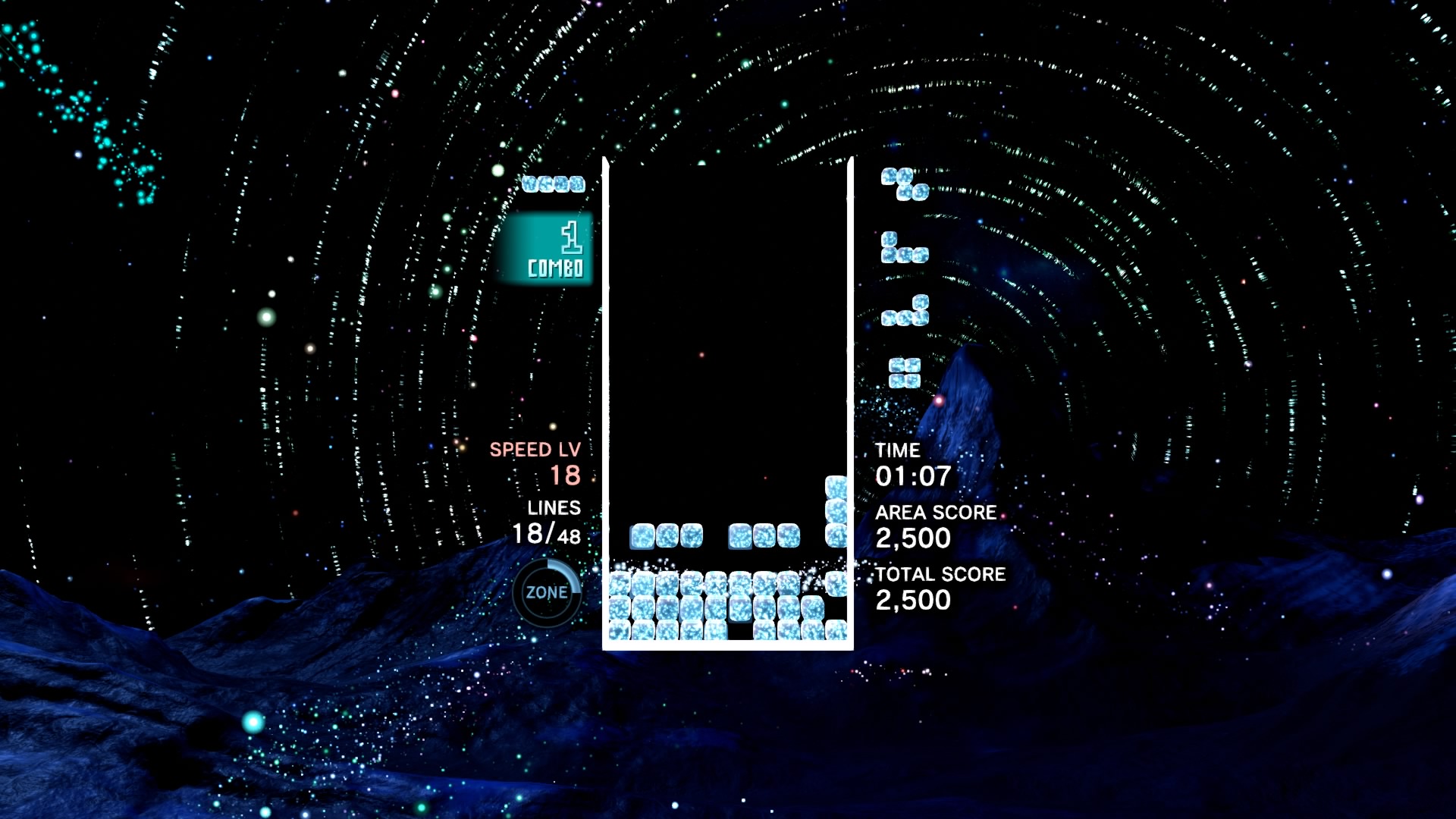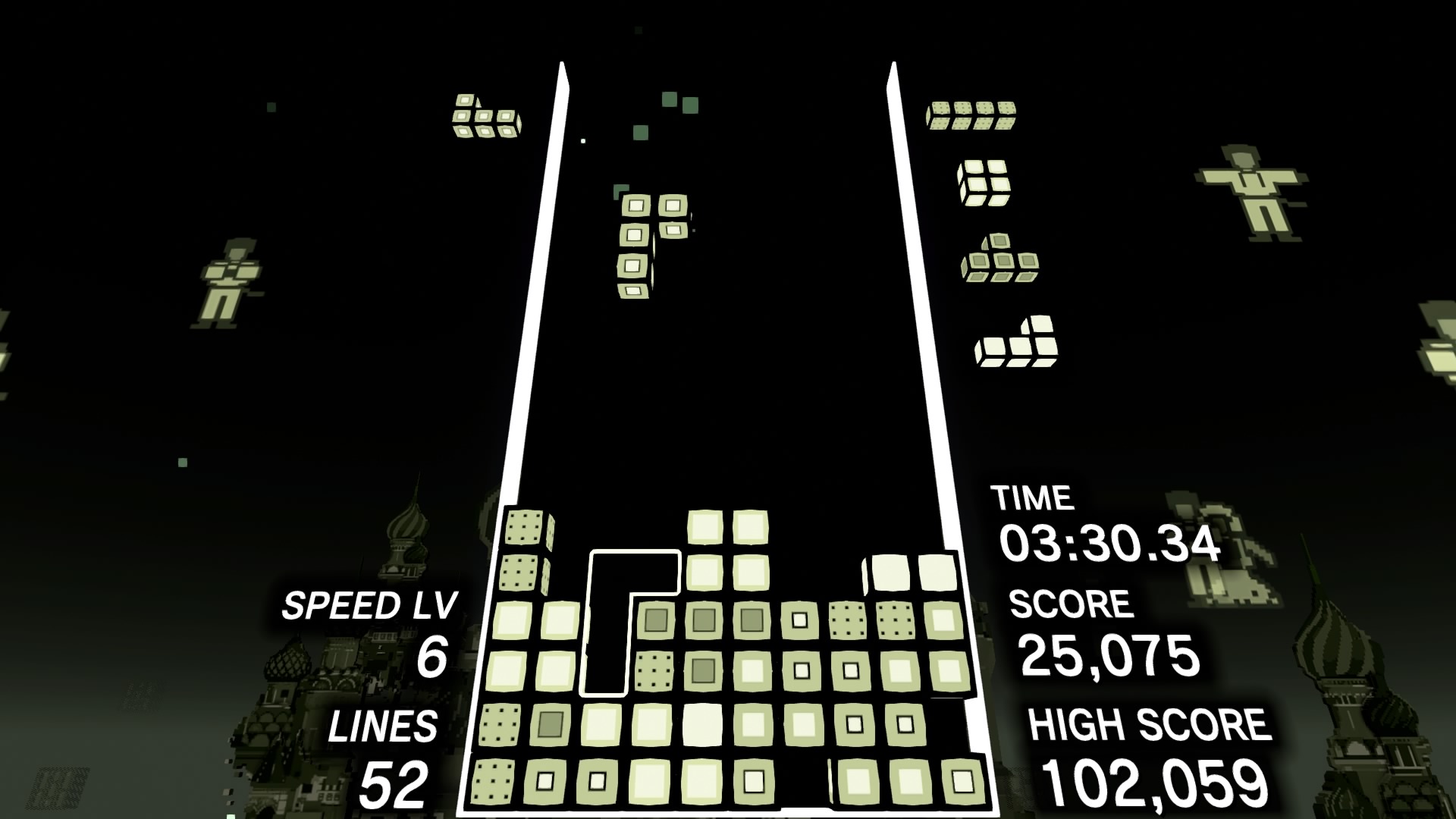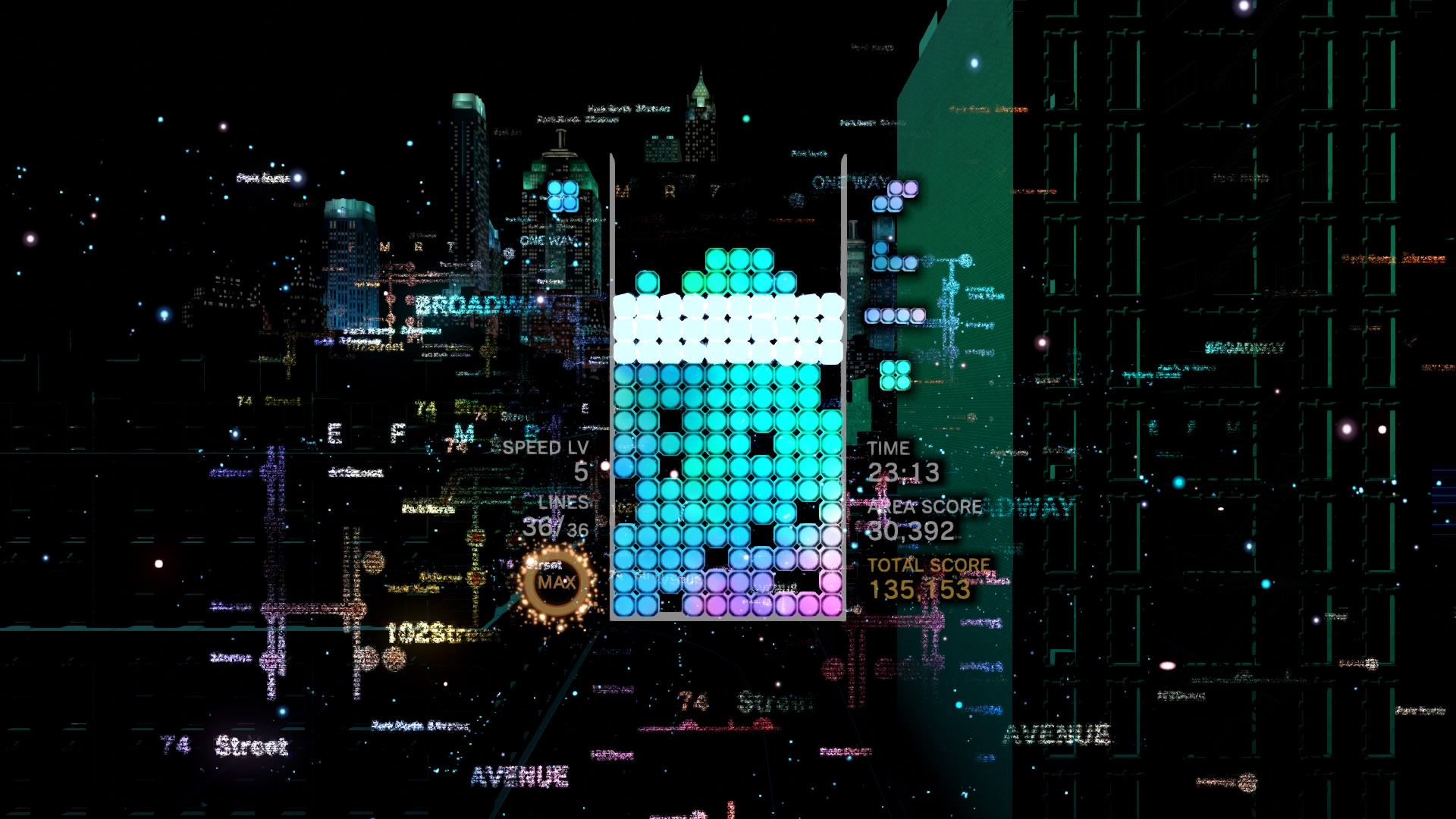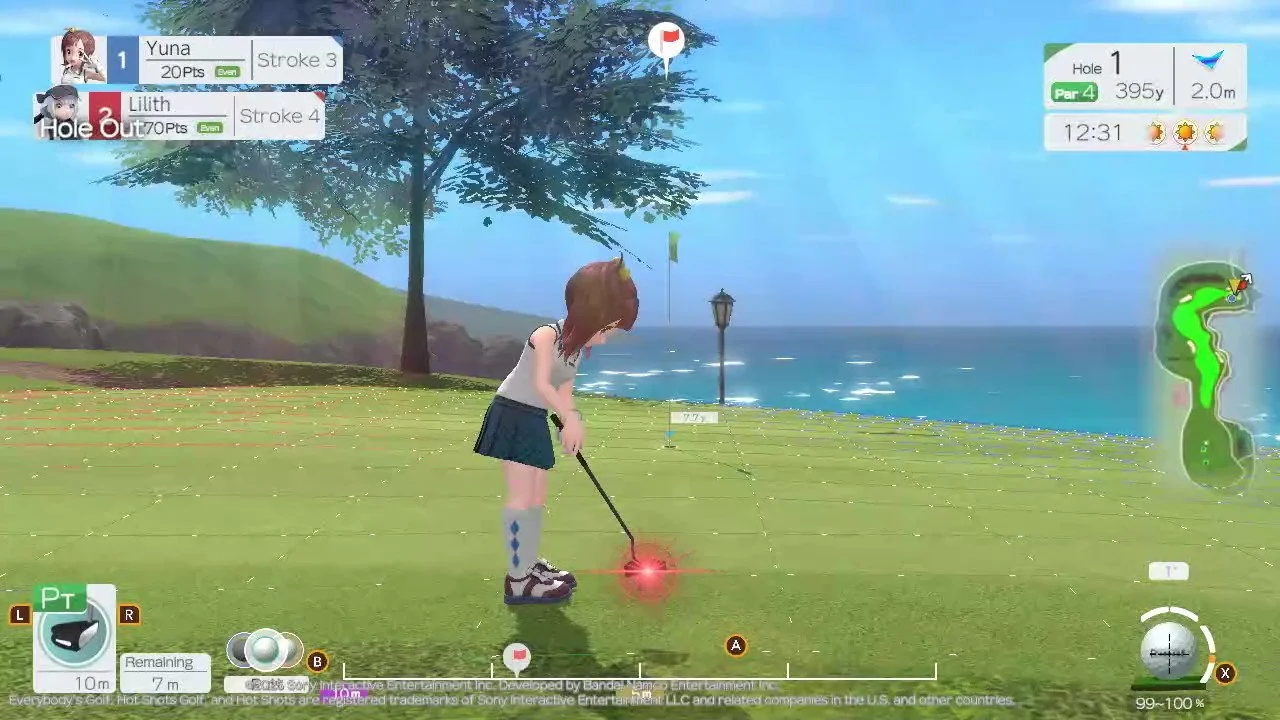Tetris Effect Review - More Bang for Your Blocks
/I closed my eyes to rest them, but behind the red membranes of my eyelids were only more falling Tetriminos. The seven shapes - I, L, J, O, T, S, and Z - became as intimately familiar to me as the lifelong friends they were as I felt myself motivated time and again to attempt the grueling gauntlet of finishing all of Tetris Effect’s songs in order, in Expert Mode, with a non-resetting board. At one point, I realized I had to put the controller down and begin writing about this game, only to stop after every paragraph and reward myself with another two hours of play.
What I was experiencing was the infamous ‘Tetris Effect’ phenomenon that is not only this game’s namesake (as well as the title of a must-read book about the incredible history of Tetris), but an actual documented set of symptoms - specifically, folks who’ve been playing Tetris for a long time see blocks falling before their eyes and in everyday objects. This phenomenon directly inspired famed game producer and musician Tetsuya Mizuguchi (Rez, Child of Eden, Lumines, Space Channel 5), who’d been trying to get a Tetris game off the ground ever since the PSP launch, and whose goal of making games that completely immerse the player in musical synesthesia coalesced in perfect harmony through the medium of virtual reality.
But even putting the PS VR experience aside (I’m too poor to own one), Tetris Effect succeeds wildly in its goals, easily delivering the most aesthetically pleasing, satisfying, and addictive take on the evergreen Tetris formula in many, many years.
“It’s not for everyone, but if you’ve ever been bitten by the Tetris bug in the past, or have enjoyed Mizuguchi’s past experiments in synesthesia, you can’t go wrong with Tetris Effect.”
Deep into the Zone
I grew up with Tetris on the Game Boy, my first ever gaming machine. My batteries would wear out before I felt satisfied with my play. Over two and a half decades later, I’m still not satisfied with my play. Such is the simple perfection of Tetris, and even with all its innovations, Tetris Effect doesn’t attempt to fix what isn’t broken. What it does do, however, is introduce a major new mechanic - the Zone.
In the game’s 27-song campaign, Journey, as you gain more points, a Zone meter fills up. If you perform combos, drop pieces seamlessly and quickly, and rack up back-to-back Tetrises, it will fill even faster. Hitting R2 activates Zone, freezing the game board and giving you a liberal amount of time to drop Tetriminos. Cleared lines don’t disappear, but they do get out of the way, making it easier for you to continue your combo, which can go until you run out of time or hit the ceiling.
There’s hardly anything more satisfying than racking up 16 clears at a time (Decahexatris), unless it’s a Perfectris (18 line clears) or Ultimatris (20 lines) It’s technically possible to get 21 as well, with a lot of skill and a little luck.
The Zone mechanic is simple, but it adds layers of depth to the game. You can pop your Zone if you see an opportunity to score big, even if the meter isn’t full, or if you need to save yourself from a bad situation and buy time. Mastering the Zone is essential for earning high scores.
Normally, points can be efficiently racked up in several ways: you can chain line clears one after another for combos, pull off four-line Tetrises (1000 points each), or you can perform a T-Spin Double clear (‘walk’ a T-shape through a gap to perfectly clear two lines) for a whopping 2000 points.
We’re all connected
On top of the mechanics, the other thing about Tetris Effect that really impressed me was the level design - if you can call it that - since each level has its own signature visual style; blocks change from fire to ice to leaves to rippling water, and the animated backgrounds morph and mature with the tempo, with entrancing particle effects popping/pulsing whenever you clear lines. Each of the distinct boards also has an evolving soundtrack, which is tied to your own movements. Some of them begin with ambient sounds, such as falling rain, vocal samples, whispers, chimes, or bells, and gradually build and develop into layered aural symphonies, all with matching controller vibration (similarly to Child of Eden, you can also set other controllers to rumble and sit upon a throne of force feedback). Then there are the full-on vocal tracks, some of whom were included in the pre-order bonus Soundtrack Sampler, though a full soundtrack release is apparently a bit of a ways off. Not all of the songs are perfect (my brother and I disagree on some of their merits), but there’s a huge variety of tracks, and they all sound a lot better with headphones.
Picture Lumines’ addictive nature cranked up to eleven - that’s Tetris Effect in a nutshell. I was hypnotized by the melding of the constant assaults on my senses contrasting with and informing my logical brain’s need to mix and match the blocks to properly chain Tetrises and T-Spins. Via its unmatched presentation and highly addictive rhythmic elements, Tetris Effect makes the challenge of improving at Tetris (a lifelong one for some folks) fun and engaging. I often fall into trancelike states when playing, so I can only hope there weren’t any Satanic subliminal messages hidden in the frequencies. On the bright side, there’s been evidence that playing Tetris can increase brain efficency.
More bang for your blocks
In addition to the Journey campaign, Tetris Effect also boasts fifteen other modes of play in the form of the Effect Modes, which are divided into four categories: Classic, Relax, Focus, and Adventurous, and all of which feature leaderboards so you can see where you rank worldwide.
Classic has the time-tested line challenges you’d expect in a Tetris title. There’s of course the standard Marathon mode, where you’ll be challenged to complete 150 lines on your level of choice. You can also opt to go Endless on Marathon and see how long you can last. Among the other modes, Master is an insanely fast challenge for the true pros.
The Relax modes offer playlists remixing certain levels (Sea, Wind, World) for those more interested in the game’s synesthetic qualities.
“Picture Lumines’ addictive nature cranked up to eleven - that’s Tetris Effect in a nutshell.”
Those trying to hone specific skills would do well to partake in the timed Focus challenges, which test your speed, adaptability, and reflexes in achieving All Clears, combos, and clearing target blocks.
The Adventurous challenges are perhaps my favorite. Countdown sends I-Tetriminos (foreshadowed ahead of time) dropping down - you’ll need to build around them to rack up combos. Purify tasks you with clearing certain blocks that, left unchecked, will expand and infect your board, while Mystery sends random terrible effects at you (very large blocks, garbage blocks, rearranging blocks, flipping the board upside down, etc.) that test your adaptability.
There are also weekly online co-operative events where you can test your mettle against other players around the globe. All of the above modes are fun diversions and feature more original music and effects, impressing me with the sheer amount of work developers Enhance, Inc., Monstars and Resonair put into this title, which apparently took over six years to create.
A journey worth taking, even alone
The only glaring omission from Tetris Effect is any sort of multiplayer mode. I understand that the rhythm-based gameplay might make local multiplayer awkward or discordant, but couldn’t two pairs of headphones solve that issue? Also, head-to-head online play would have been a real treat. Another complaint I have is the lack of an ability to move the next piece and held block indicators from the top of the screen. Considering that by default, Tetriminos are all of the same color and texture (you can change this, but it does remove each board’s custom block effects), it’s often impractical to take your eyes off the board even just to glance through your list of upcoming blocks. It’d be much easier to parse that essential information quickly if we had an option to enlarge that list or move it lower on the screen.
As someone who gets hopelessly addicted to block-matching games, I’ve put time into dozens of Tetris games and spinoffs - Puyo Puyo, Panel de Pon/Tetris Attack, 3D Tetris, Tetrisphere, Tetris DS, Lumines, Puzzle Quest, you name it - and while all of those games have their own merits, none of them deliver the raw, visceral, immersive, cinematic experience that Tetris Effect does. It expands the appeal of the genre and introduces cool new mechanics, all without sacrificing or compromising the core gameplay of one of the best and most iconic games of all time. It’s not for everyone, but if you’ve ever been bitten by the Tetris bug in the past, or have enjoyed Mizuguchi’s past experiments in synesthesia, you can’t go wrong with Tetris Effect. Also, definitely get to level 50 to unlock the game’s best Easter Egg, a real treat for old-school fans.
9/10
Highlights
+ A beautiful, immersive, and challenging single-player Journey campaign
+ The memorable dynamic soundtrack boasts a lot of variety
+ Fifteen extra modes and online leaderboards provide replay value for the hardcore
- No local or online multiplayer
- If you dislike Tetris and rhythm games, this won’t change your mind
What I Played
Over 50 hours of block-matching action
Achieved level 56 - Master rank
Achieved A or better in all Expert Journey levels
Achieved SS rank in Endless Marathon mode



















SEGA and Ryu Ga Gotoku Studios put a ton of love and care into Yakuza Kiwami 2, and it runs flawlessly on Switch 2. If you’re like me and itching for a reason to take a plunge into the Yakuza universe, there’s no better time than the present.